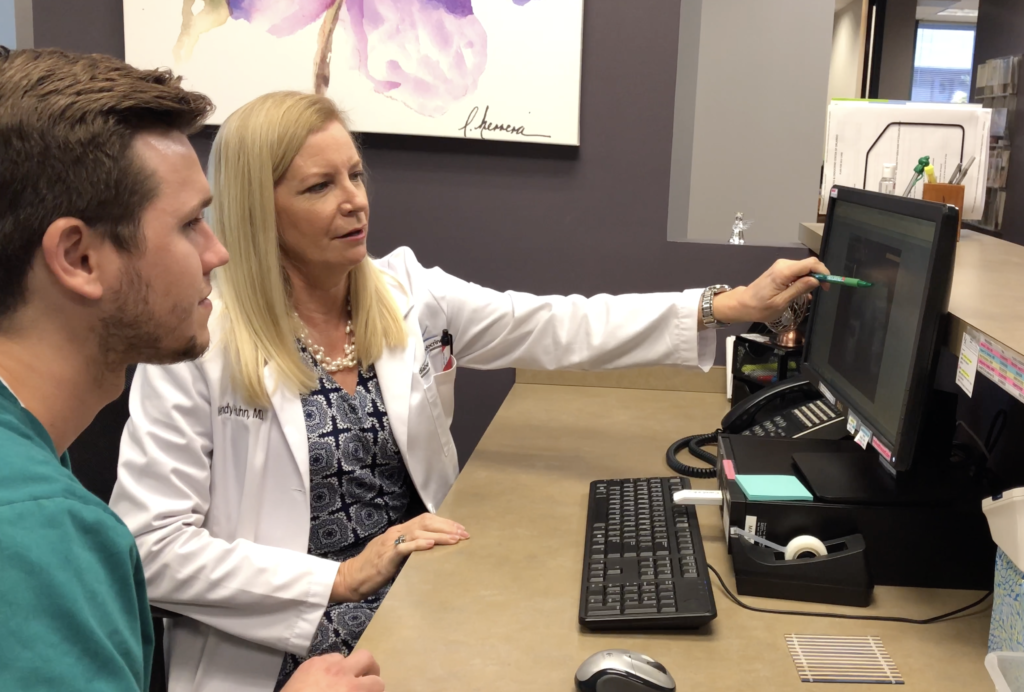Glucose meters are fantastic tools, but sometimes you need to keep a closer eye on your blood sugar levels. That’s where a device called a continuous glucose monitor (CGM) can help. A CGM system can help you better manage your daily glucose levels, avoid low blood glucose emergencies, and require fewer finger sticks. According to Wendy C. Huhn, M.D., F.A.C.E., a board-certified clinical endocrinologist at the Diabetes and Endocrine Center of Orlando, a CGM can help detect trends and patterns that give you and your physician a more comprehensive view of your diabetes. And the information can help you discover ways to manage your condition more effectively.
“CGM is very useful for us to determine a specific pattern for each person with diabetes,†says Dr. Huhn. “So that we can see where the problem times are during the day and overnight.â€
What Is Continuous Glucose Monitoring?
 Continuous glucose monitoring automatically tracks blood glucose levels, also called blood sugar, throughout the day and night. You can see your glucose level anytime at a glance. You can also review how your glucose changes over a few hours or days to notice trends. Understanding glucose levels in real-time can help you make more informed decisions throughout the day about how to balance your food, physical activity, and medicines. Moreover, the information provided by your monitor can help you and your doctor make the best plan for managing your diabetes, including:
Continuous glucose monitoring automatically tracks blood glucose levels, also called blood sugar, throughout the day and night. You can see your glucose level anytime at a glance. You can also review how your glucose changes over a few hours or days to notice trends. Understanding glucose levels in real-time can help you make more informed decisions throughout the day about how to balance your food, physical activity, and medicines. Moreover, the information provided by your monitor can help you and your doctor make the best plan for managing your diabetes, including:
- How much insulin you should take
- An exercise plan that’s right for you
- The number of meals and snacks you need each day
- The correct types and doses of medications
How Does a CGM Work?
A CGM works through a tiny sensor inserted under your skin, usually on your belly or arm. The sensor measures your interstitial glucose level, which is the glucose found in the fluid between the cells. The sensor tests glucose every few minutes. A transmitter wirelessly sends the information to a monitor. “We have an apparatus called an iPro, which is a professional continuous glucose monitor,†says Dr. Huhn. “It’s a small device attached to the skin for patients to be able to monitor their glucose levels about every five minutes for up to five days. The apparatus is placed at our office, and easy to wear. It’s taped over so you can shower and go about your daily routine without any interruption.†On about the fourth or fifth day of using the CGM, you’ll be asked to return to the doctor’s office. Sometimes a series of lab tests will be done, the information inputted into a computer program, and the glucose levels uploaded and placed on a graph. According to Dr. Huhn, that way, your doctor can see where the blood sugars are on average for all times of the day. “CGM results allow us to determine what your insulin needs are or pinpoint which specific oral medications you may need,†she says. “If we see that your blood sugars rise overnight, then we know that certain medications will work best for that. Or if everything’s fine at night, but the blood sugars are going up after meals, then there are different treatments for that. CGM becomes very useful to give you a plan of action in a fairly swift period so that we can get you on what’s best to control your diabetes and lower your A1C.â€
What Are the Benefits of a CGM?
 In the past, only doctors could see the readings CGM systems collected. Now anyone can use the devices as part of at-home diabetes care. You can download data on your computer, tablet, or smartphone to see patterns and trends in your sugar levels. “The CGM is monitoring all the time,†Dr. Huhn continues. “We ask our patients to keep a diary when they eat and to perform their own finger stick, so that it correlates nicely with the readout we eventually get.†Compared with a standard blood glucose meter, using a CGM system can help you:
In the past, only doctors could see the readings CGM systems collected. Now anyone can use the devices as part of at-home diabetes care. You can download data on your computer, tablet, or smartphone to see patterns and trends in your sugar levels. “The CGM is monitoring all the time,†Dr. Huhn continues. “We ask our patients to keep a diary when they eat and to perform their own finger stick, so that it correlates nicely with the readout we eventually get.†Compared with a standard blood glucose meter, using a CGM system can help you:
- Better manage your glucose levels every day
- Have fewer low blood glucose emergencies
- Need fewer finger sticks
A CGM doesn’t replace traditional home monitors, however. You’ll still need to measure your blood sugar with a regular glucose meter a few times a day to help the monitor stay accurate.
Is CGM Right for You?
Most patients who use CGMs have type 1 diabetes. Research is currently underway to determine how CGMs might help people with type 2 diabetes. A CGM is available for use by adults and children with a doctor’s prescription. Your physician may recommend using a CGM system all the time or only for a few days to help adjust your diabetes care plan. For more information on how CGM may be able to help you manage diabetes, please feel free to contact us.



Leave A Comment